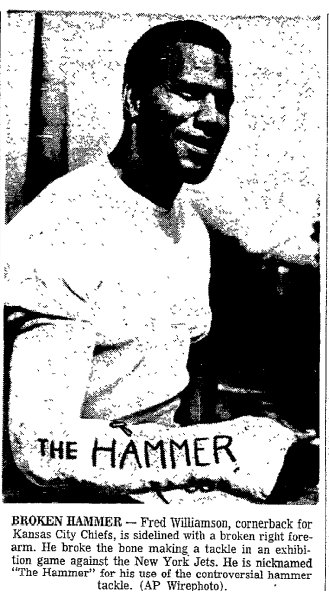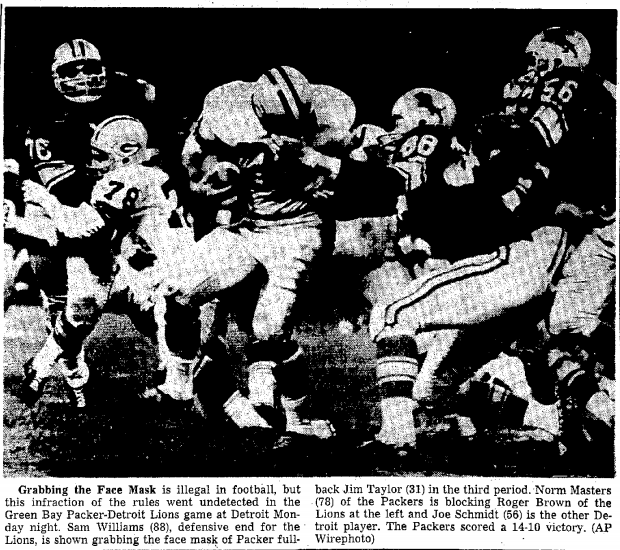My Internet wanderings recently led me, as they often do, to an unexpected place: a classic 1967 photo of Chiefs cornerback Fred “The Hammer” Williamson. It shows Williamson, famous for bludgeoning receivers with a karate chop to the head, wearing a cast on his feared right forearm — “THE HAMMER” written in big block letters across it. He’d broken the arm in an exhibition game two weeks earlier against the Jets. The New York Times described the collision this way:
In the first quarter [Jets quarterback] Joe Namath completed a 15-yard pass to Don Maynard, who was covered by Fred Williamson. The talkative Williamson tackled Maynard, his right elbow crashing into Maynard’s spine near the neck. Williamson’s right arm was broken on the play. Maynard suffered a slight concussion and was sent to University Hospital [in Birmingham, Ala., where the game was played] for observation.
Williamson’s “Hammer” — “having great velocity and delivered perpendicular to the earth’s latitude,” as he liked to say — usually won these battles. The year before, he’d fractured the cheekbone of the Dolphins’ Howard Twilley. Anyway, here’s the photo of Fred’s arm encased in plaster:
Pro football back then was still fairly cavalier about shots to the cranium. The head slap had become a popular — and legal — weapon of defensive linemen, and high hitting like Williamson’s tended to be tolerated as long as the victim wasn’t decapitated. It was a far cry from the concussion-conscious times we now live in. In the ’60s there was no such thing as “targeting” a “defenseless” player. That was just, well, football.
It wasn’t until 1962 that the NFL made it illegal to grab the ball carrier’s facemask. (Until then, he was the only one exempted from the rule — for some strange reason.) In high school and college ball, grabbing anybody’s face mask had been a personal foul since 1957.
By then, David M. Nelson writes in Anatomy of a Game, “large numbers of players were wearing face guards, and opponents were grasping them legally and putting the wearer at a disadvantage. Citing the injury possibility with grasping and holding, the Rules Committee passed the first 15-yard face mask penalty.”
That happened this very week in 58 years ago (which is why I wanted to post about it). Talk about a red-letter day in football safety. The NFL was still a ways away, though, from giving the ball carrier the same protection. When it finally did, Commissioner Pete Rozelle made some interesting comments.
“It has been against the rule to grab face masks in blocking,” he said, “but you could grab the mask of a ball carrier. But the ball carrier actually is the most defenseless of all, and this new rule could prevent possible serious injury.”
More from Rozelle: “We didn’t have any serious trouble with this in league play. Actually, most of our injuries are of the knee or leg type. However, I did see one ball carrier grabbed by his mask and thrown several yards. It scared me a little.”
As well it might.
(I love this headline that ran in a newspaper the day after the rule was passed — specifically the “for ’62” part. Did people actually think the league might change its mind about rule and repeal it?)
 It took defensive players — some of them, at least — a while to adjust to the revised rule, as this 1964 photo shows. That’s Lions’ end Sam Williams trying to yank down Jim Taylor, the Packers’ Hall of Fame fullback:
It took defensive players — some of them, at least — a while to adjust to the revised rule, as this 1964 photo shows. That’s Lions’ end Sam Williams trying to yank down Jim Taylor, the Packers’ Hall of Fame fullback:
Just thought, with such a (needed) emphasis on player safety these days, it was a good time to revisit Fred “The Hammer” Williamson and celebrate the 1957 passing of the face mask rule — even if it took the NFL a little longer to wise up.


